Wildflowers
Canyon Country Nature GuideWildflowers have adapted to the arid environment of canyon country in many ways. Some have thick, waxy coatings on leaves and stems or small leaves to reduce water loss due to evaporation, some have deep taproots to reach moisture, while others have shallow widespread roots that absorb surface water quickly. Seeds may lie dormant for years if conditions are not favorable, germinating only after significant rainfall.
Wildflowers are highly variable year to year. April and May are generally the best months to see them in bloom, and some produce flowers again in fall if there has been sufficient rain.
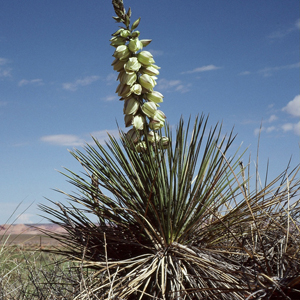
Harriman's Yucca
(Yucca harrimaniae)
Yucca plants are 3.9” to 1.6’ (10 cm to 1.5 m) tall. The majestic flower spikes appear from April through June. These spiky-leaved plants are widespread throughout the park. The genus name, “Yucca”, is a Caribbean name for a totally different plant. The species name, “harrimaniae”, honors the, philanthropists who funded collecting expeditions. Yucca was an important native plant used by the Ancestral Pueblo people in the Southwest. It supplied food in the form of blossoms, fruits, and roots; fiber for weaving sandals and rope; soap and shampoo from the roots; and the ends of the sharp, pointed leaves made excellent needles for sewing. This plant has a deep taproot, at least 30 feet (9 m) long.

Scarlet Globemallow
(Sphaeralcea coccinea)
Globemallow is 7.7” to 3.3’ (19.5 cm to 1 m) tall. Its lovely orange blooms can be spotted throughout the park. Globemallows close their flowers at night. Temporarily captured bees of the Diadaysia genus that pollinate them can sometimes be found curled up in the flowers in the morning. Small birds, prairie dogs, jack rabbits, and other small mammals forage on scarlet globemallow.
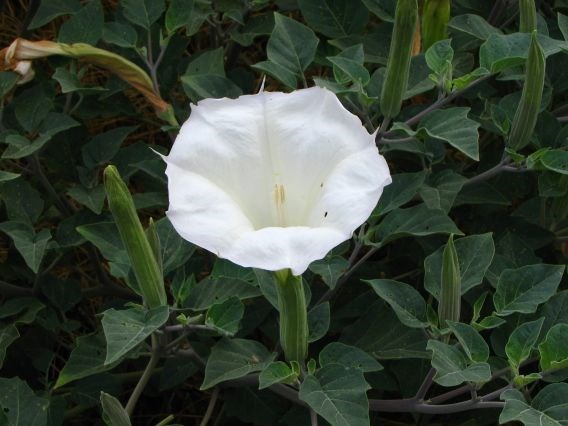
Sacred Datura
(Moonflower)
(Datura wrightii)
Datura is from 11.8” to 3.3’ (30 cm to 1 m). It produces the largest flower in canyon country. The beautiful large white flowers open at night to release their sweet fragrance. You may see datura blooming between May and October near the Devils Garden Trailhead. The species name, “wrightii” honors American botanical collector, Charles Wright (1811-1885). This is a poisonous, narcotic plant that can lead to death if eaten.
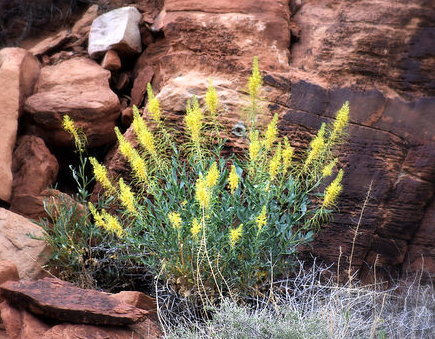
Prince's Plume
(Stanleya pinnata)
Prince’s Plume is from 9.8” to 4.9’ (24 cm to 1.5 m) tall. The feathery yellow “plumes” bloom from April through October. The genus name, “Stanleya”, honors British naturalist Lord Stanley. The species name, “pinnata”, means “feather-shaped, pinnate” and refers to the deeply dissected leaves.
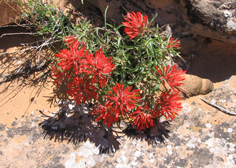
Common Paintbrush
(Desert Paintbrush)
(Castilleja chromosa)
Paintbrush plants range from 4” to 20″ (10 to 50 cm) tall and bloom from March through June. Paintbrush is commonly seen throughout the area. The genus, “Castilleja”, honors Domingo Castillejo, an 18th century Spanish botanist. The species name, “chromosa”, means “red” which describes the color of the flower’s bracts. This plant is semi-parasitic, getting part of its nutritional needs from other plants by attaching to the host plant’s roots.
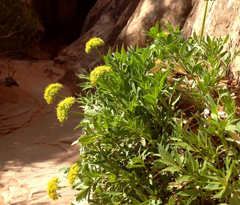
Parry's Biscuitroot
(Lomatium parryi)
Parry’s Biscuitroot (Lomatium parryi) Biscuitroot is a small plant that is 3.2” to 1.3′ (8 to 40 cm) tall. Its small yellow-green flowers top the plant in spherical umbels. Biscuitroot blooms in March and April. The species name, “parryi” honors Charles Christopher Parry (1823-1890) the first official botanist for the U.S. Department of Agriculture. The common name refers to Native American use of the roots to make flour.
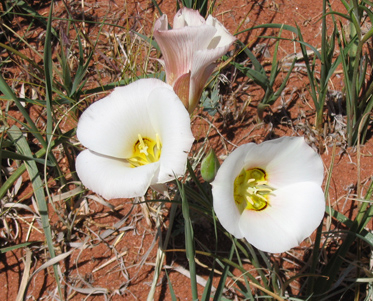
Sego Lily
(Nuttall’s Mariposa)
(Calochortus Nuttalliia)
The beautiful sego lily is 3.2” to 19″ (8 to 48 cm) tall. It blooms from April through June. The genus name, “Calochortus”, is from the Greek “kalos” which means “beautiful” and “chortos” which means “grass” referring to the leaves. The species name, “nuttallii”, honors Thomas Nuttall (1786-1859), a botanist, ornithologist, curator of the Harvard Botanic Gardens. Sego lily is the state flower of Utah.
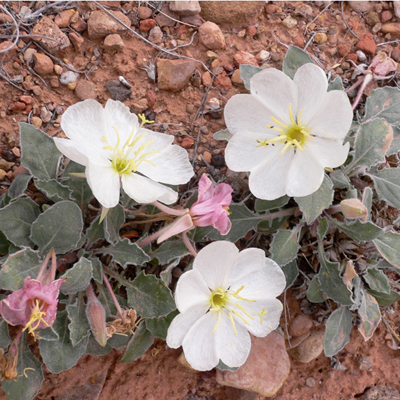
Dward Evening-Primrose
(Oenothera caespitosa)
Dwarf Evening-primrose (Oenothera caespitosa) Dwarf evening-primrose is a small plant that is 0.6” to 12” (1.5 to 30 cm) tall. The white four-petaled flowers usually open in late afternoon or evening and fade to pink after pollination. This delicate plant blooms from March through early November. The genus name, “Oenothera”, means “wine-scented” and refers to the use of the roots in winemaking. The species name, “caespitosa”, means “low growing” and refers to the stature of the plant flowers.

Claret Cup
(Echinocereus triglochidiatus var. melancanthus)
This member of the cactus family is 3.2” to 6” (8 to 15 cm) tall and blooms from April through June. Claret cup grows in clumps and has showy red flowers. The cactus’s resemblance to the hedgehog inspired both this plant’s scientific name “Echinocereus” (from Greek “echinos”, meaning “hedgehog”) and its nickname “hedgehog cactus”.

Prickly Pear
(Plains Prickly Pear)
(Opuntia polyacantha)
These cacti are from 2” to 8” (5 to 20 cm) tall, and 1′ to 10′ (.3 to 3 m) wide (or more). The green “pads” are modified stems and the spines are leaves adapted to help this plant survive with very little water. It blooms from April through June with yellow, bronze, or pink, flowers. Prickly pear cacti are found throughout the area. The genus name, “Opuntia”, is the Greek name for a spiny plant that grew near Opus Greece. “Polyacantha” means “many spines”. Prickly pears provide protection for small animals and birds. The pads are nibbled in times of drought and the fruits are eaten by many animals.
